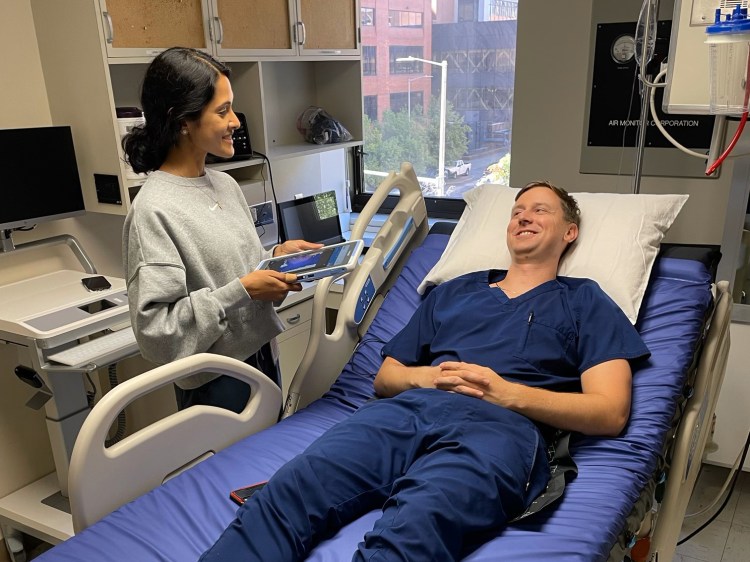Under Pressure: Clin Sim partners on pressure-mapping project

What type of alternating pressure mattress is better suited for patients with spinal cord injuries?
It’s a question Dr. Cynthia Francis hopes to put to bed.
As a fourth-year resident in UAB Heersink School of Medicine’s Department of Physical Medicine and Rehabilitation, Francis broached the topic as the subject of her scholarly activity project.
“This project started out when I was a PGY2 (post-graduate year two) on the spinal cord injury unit at Spain Rehabilitation (Center),” Francis said. “We use an alternating pressure mattress specific just to the spinal cord injury unit, the purpose of which is to provide pressure relief to reduce sacral or ischial skin breakdown or pressure injuries. The spinal cord injury population is at very high risk for these kinds of injuries … and we were having a lot of admissions of patients from outside hospitals who developed worsening skin breakdown.”
Francis stressed that this is a major concern for that particular patient population, as it can lead to major medical issues and injuries down the road.
“We wanted to target this from not only a quality perspective, but also from a patient care perspective,” she said. “So, one thing that my attendings and I were considering was maybe we should take a closer look at the type of hospital beds we’re using and see if they’re offering optimized pressure relief for these patients.”
Francis then designed an IRB-approved study that would compare the primary mattress used at Spain Rehab with the primary mattress used by the wound care team at UAB Hospital.
“At UAB main, whenever there’s concern for pressure injury or a developing pressure injury, the wound care team monitors the situation very closely, and if there’s enough concern, they have a specific type of bed system they like to use for those patients,” Francis explained. “We wanted to compare both of these mattresses and see if there’s any difference.”
To do so, Francis would need to simulate those respective environments. Enter UAB Clinical Simulation. Working with Ben Whitaker, manager of Clinical Simulation operations, Francis was able to obtain both types of mattress systems and place each in a simulated patient room in the Clinical Simulation lab in UAB Hospital’s Quarterback Tower.
She recruited a group of healthy volunteers, including co-residents and faculty members, and set to work. The volunteers agreed to lay on each of the two mattresses for specific periods of time, while a pressure mapping square placed beneath their sacra recorded the pressure relief for observation.
“These two types of mattresses are offering similar levels of pressure relief, and we’re hoping to determine whether they’re the best choice for our patients or if we maybe need to look at alternative options or different types of supportive surfaces,” Francis said.
With the raw data gathered, Francis now looks forward to extrapolation and analysis.
“Hopefully, there are more studies we can branch off of this, but this is kind of our first step into this endeavor,” she said.
According to Whitaker, Clinical Simulation was happy to play a part.
“The Clinical Simulation team was grateful for the opportunity to help support this project,” he said. “In addition to providing the space and supplies for Dr. Francis’s study, we were able to meet and work with different vendors in order to procure the necessary equipment, such as beds and mattress systems. We always value the opportunity to collaborate with other teams and contribute toward these important efforts that help improve patient safety.”
Learn how UAB Clinical Simulation can benefit your staff, team or department by emailing simulation@uabmc.edu.
UAB Medicine’s Clinical Simulation program offers opportunities for individuals and teams across UAB Medicine to practice before they deliver care. We encourage all who provide and support patient care to “SimFirst.” Together, we can put our patients’ safety first.




0 Comments